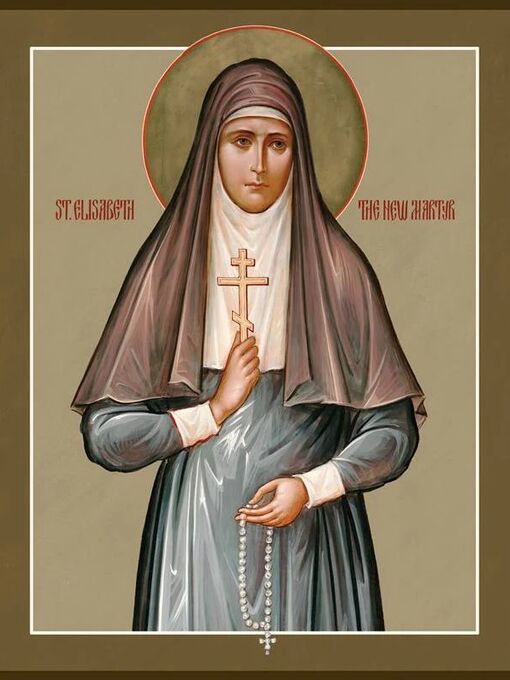
Chris & Samara
Chris & Samara
Our Patrons
Our Patrons
St. Herman of Alaska (Chris's Patron Saint)

Saint Herman of Alaska, America’s first canonized saint, was an Orthodox Christian monk of holy life who lived in Valaam Monastery in Russia.
In 1794, along with nine other monastics he was sent to Alaska to evangelize the natives there. In time St. Herman would become the sole survivor of the original missionaries. Throughout his long life he cared for the natives of the Kodiak area, nursing them in their illnesses, educating them, and defending them from the abuse of the Russian fur-traders. By his meekness and firm faith he won the love and respect of all who came to know him, and inspired many to follow Christ. Eventually settling on nearby Spruce Island, he lived a mostly eremitic life, while also establishing an orphanage for the children of parents who had died during epidemics.
By the power of God, St. Herman was able to see into the hearts of others. He worked miracles during his life, such as stopping a forest fire and a tsunami by his prayers. To this day he remains a wonderworker, healing the souls and bodies of those who ask for his intercessions before the throne of God.
Saint Herman remained on Spruce Island for nearly his entire life, devoting himself to prayer and manual labour. Despite being considered for ordination as a hieromonk and elevation to the rank of archimandrite, he humbly declined any positions of authority, choosing to remain a simple monk until his peaceful repose in December 1836 at 81.
St. Elizabeth the New Martyr (Samara's Patron Saint)

Saint Elizabeth was born in Germany in 1864 to a noble family. At age 14 she was orphaned, and was raised in part by her grandmother, Queen Victoria of Great Britain.
She married into the Russian Royal Family in 1884, joining to her husband, Grand Duke Sergei. Raised in the Lutheran faith, she decided to convert to Orthodoxy seven years later.
When her husband was assassinated in 1905, Grand Duchess Elizabeth sold most of her possessions and opened a women's monastery in Moscow, which ministered to the poor, sick, and orphans of the city.
After the communists took control of Russia, Lenin ordered Elizabeth's arrest. Together with several other members of the Royal Family, she was exiled and constantly moved from place to place.
On July 18, 1918, the captors beat Elizabeth and the others and cast them into a mine shaft. All but one of them survived the fall, and they began to sing hymns. One of the guards threw a pair of grenades into the pit, which exploded, but the singing continued. Finally, the mine was set on fire.
Their remains were recovered and buried at the Russian Mission in Beijing, and later moved to the Church of St. Mary Magdalene in Jerusalem, where they are enshrined today. Saint Elizabeth was glorified in 1981 by the Russian Church Abroad and in 1992 by the Church of Russia. Her feast is celebrated on July 5/18.
St. John of San Francisco (Patron Saint for our Marriage)

St. John the Wonderworker was born in the village of Adamovka in the Kharkov Governorate (in present-day southern Ukraine).
After receiving a law degree he and his family fled their country as the Bolshevik revolutionaries descended on the country, emigrating to Yugoslavia. There, he enrolled in the Department of Theology of the University of Belgrade. He was tonsured a monk and ordained a deacon in 1926 and later that year ordained to the priesthood. In he was ordained a bishop and assigned to the diocese of Shanghai. Here Saint John worked to restore unity among the various Orthodox nationalities.
He became known for miracles attributed to his prayer, ministered to the sick, and built churches, hospitals, and orphanages among the Orthodox and Russians of Shanghai. With the end of World War II and the coming to power of the Communists in China the Russian colony was forced to flee from Shanghai. Saint John travelled to Washington, D.C. to lobby to amending the law to allow these refugees to enter the United States.
In 1951 John was assigned to the archdiocese of Western Europe with his see first in Paris, then in Brussels. In 1962 John was reassigned to the see of San Francisco. On July 2, 1966 St. John died while visiting Seattle at a time and place he was said to have foretold. He was entombed in a sepulcher beneath the altar of the Holy Virgin Cathedral he had built in San Francisco dedicated to the Theotokos, Joy of all who Sorrow on Geary Boulevard in the Richmond district.
2 July 1994 In preparation for this glorification, the tomb containing his relics was opened. When the sepulcher cover was removed, the metal coffin was found to be in a poor state of preservation due to moisture. Rust has eaten through the coffin and the cover was rusted tightly shut.The relics (the body) of Archbishop John, however, were found to be totally incorrupt. His skin was white an soft, and upon lifting out his body it was found to be very light due to dehydration but was totally intact. Those who came forward to venerate the relic discovered that they exuded a sweet fragrance.